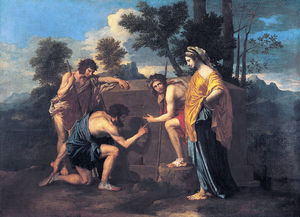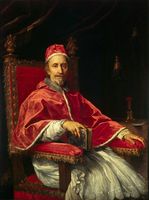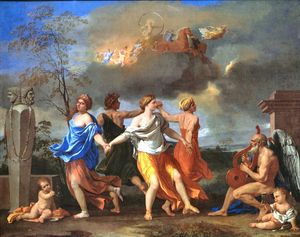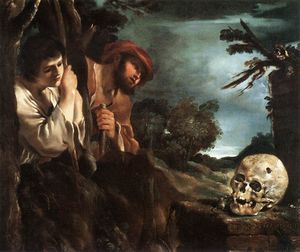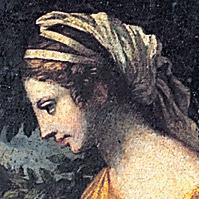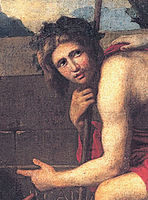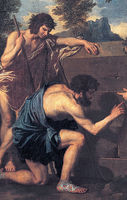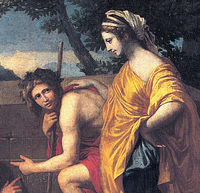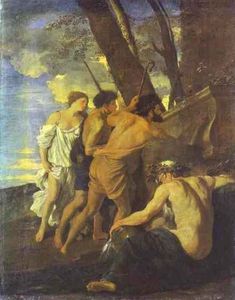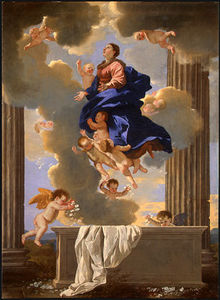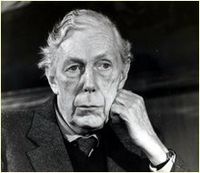The Arcadian Shepherds
- Date of Creation:
- 1639
- Alternative Names:
- Et in Arcadia Ego, Les Bergers d'Arcadie
- Height (cm):
- 121.00
- Length (cm):
- 185.00
- Medium:
- Oil
- Support:
- Canvas
- Subject:
- Scenery
- Art Movement:
- Baroque
- Created by:
- Current Location:
- Paris, France
- Displayed at:
- Musée du Louvre
- Owner:
- Musée du Louvre
- The Arcadian Shepherds Page's Content
- Story / Theme
- Inspirations for the Work
- Analysis
- Critical Reception
- Related Paintings
- Artist
- Art Period
- Bibliography
The Arcadian Shepherds Story / Theme
The Arcadian Shepherds (also known as Les bergers d'Arcadie or Et in Arcadia Ego) is without a doubt the most famous and most widely discussed of any of Poussin's paintings.
This image depicts three shepherds and a monumental, statue-like woman grouped around a large stone tomb. The idyllic natural setting, the antique robes and sandals of the figures, and, of course, the painting's title all situate this in the mythical realm of Arcadia.
Arcadia was a real region in Greece: isolated, surrounded by mountains, and sparsely populated by shepherds, already in antiquity the region was romanticized as a kind of terrestrial paradise, a place of unspoiled nature whose inhabitants still lived in the blissful harmony (and ignorance) of the Golden Age.
The myth of Arcadia has inspired poets and artists alike through the millennia, notably the Roman poet Virgil, whose Eclogues (a series of poems which take place in Arcadia) were one of the major inspirations for this painting.
In the midst of this paradise, however, these shepherds look somewhat concerned. What is it that they are examining with such perplexed intensity? A tomb, with the phrase Et in Arcadia Ego inscribed in the center. This Latin phrase roughly translates into English as "Even in Arcadia I exist," referring to the contents of the tomb: death. These shepherds are thus discovering their own mortality.
The Commission:
Poussin's The Arcadian Shepherds was commissioned in 1638 by Giulio Rospigliosi (the future Pope Clement IX), who had also commissioned Poussin's other great masterpiece, Dance to the Music of Time, a few years earlier. Rospigliosi was a true lover of the artists who was also a well-known opera librettist. The Arcadian Shepherds was acquired by Louis XIV in 1685, and has remained in Paris ever since.
The Arcadian Shepherds Inspirations for the Work
Poussin's painting can be qualified as a memento mori, or reminder of death. Such pictures abounded during the Renaissance and Baroque periods, and were particularly popular in Northern Europe. The subject of The Arcadian Shepherds as such was rare and esoteric, but at least one important painting preceded Poussin's masterpiece;
Guercino, Et in Arcadia Ego. c. 1623:
This Italian Baroque artist (a student of the Bolognese master Annibale Carracci) painted a version of Et in Arcadia Ego that most likely inspired the young Poussin after he moved to Rome around 1624. Guercino's painting is a far cry from Poussin's later work, however: the mood of this painting is far more gloomy and dark, and the theme of the inevitability of death is brutally emphasized with the dominating presence of the skull on top of the tomb.
These shepherds are no longer happily frolicking in their Golden Age of bliss, but instead gaze at the tomb, broken-hearted, the knowledge of their mortality weighing heavily upon their shoulders.
The Arcadian Shepherds Analysis
Unlike other artists, Poussin never painted the same theme in the same way. He created two version of this work, the first in 1627 (see Related Paintings) Obsessed with perfecting his art, Poussin would take any opportunity to rework and improve his past paintings, and The Arcadian Shepherds is no exception. Poussin's second version of this theme is innovative for the following reasons;
The woman:
The female figure has been transformed from a sexy, windblown nymph in the background of the painting to a fully-clothed, monumental, statue-like figure who almost dominates the composition. Her pale, grayish skin and sharp, heavily contoured profile reveal the classical inspiration for this personage.
The mysterious woman still provides a beautiful contrast to the discovery of death, but in this version of the painting she is also the only figure who fully understands the meaning of the tomb's inscription, thus investing her with a far higher purpose than in the earlier painting. Art historians have waged fierce battles as to how to interpret this figure: does she represent Reason? The goddess Athena? Or is this Death herself?
The shepherds:
This composition is far more classical, rational and carefully ordered than Poussin's earlier painting. Here, the shepherds are arranged around the tomb in a careful balance, each with a different posture and attitude. The kneeling shepherd in the center is still trying to make out the inscription on the tomb, while the shepherd to the right seems to have already understood and looks questioningly towards the woman to his right.
The landscape:
Like the landscapes that Poussin would be painting in the coming decade, this depiction of the countryside is idyllic and lovely, creating another contrast with the horror of the discovery of death. Along with Annibale Carracci and Claude Lorrain, Poussin was a pioneer in the development of landscape painting.
Et in Arcadia Ego:
Poussin places the all-important inscription in the very center of the painting and the correct interpretation of this inscription is a matter of great debate in the world of art history.
The tone:
Poussin himself seems to have been a firm believer in the ancient Stoic philosophy, which was quite popular amongst the Roman intelligentsia in the 17th century. The philosophy holds that material possessions are essentially valueless, and that man must learn to tame his animal emotions and face his mortality with quiet resignation. Art historians believe that this philosophy was a fundamental inspiration for many of Poussin's paintings.
The Arcadian Shepherds Critical Reception
The meaning of The Arcadian Shepherds is one of the most hotly contested issues in the history of art. The most popular theories about Poussin's masterpiece include the following;
I am in Arcadia, too:
The Latin inscription on the tomb does not translate exactly into English: it could read "I was also in Arcadia," or "I am in Arcadia, too. " The first translation would suggest that the now-dead inhabitant of the tomb was once a happy Arcadian shepherd like those pictured in the painting.
The second would suggest that Death himself (or herself) is speaking, perhaps personified in the figure of the mysterious woman in yellow. Art historians have yet to reach a definitive conclusion about this ambiguity; the enormously influential historian Erwin Panofsky even wrote an important essay about it.
The shadow of death:
The kneeling shepherd in the center of the painting is most commonly seen as tracing the Latin inscription Et in Arcadia ego with his finger. The shadow he casts is thus interpreted as a literal foreshadowing of his future death.
Some have interpreted his gesture differently, however; one interpretation holds that the shepherd has in fact noticed his shadow, and that this is what he attempts to trace. According to the ancient historian Pliny, just such an episode marked the creation of painting itself; if Poussin was quoting this episode, then, The Arcadian Shepherds could be interpreted as a commentary on the development of art as a rational response to mortality.
Conspiracy theory:
Today, art historical travesties like The Da Vinci Code has left much of the art-loving public hungering for a good, thrilling mystery to go with classic paintings. Quite a few have arisen concerning Poussin's The Arcadian Shepherds, which is perhaps unsurprising considering the somewhat unnerving and esoteric nature of the painting.
One theory, put forth by authors Bagient, Leigh and Lincoln in their book The Holy Blood and the Holy Grail, holds that the famous Latin inscription was actually meant to be an anagram for I! Tego arcana Dei, meaning "Begone, I keep God's secrets!" The authors take this fanciful translation to mean that the tomb in Poussin's paintings carries the remains of Jesus Christ, or at least some other important biblical personage.
Richard Andrews and Paul Schellenberger published a similar theory in their The Tomb of God. This time, the authors claim that the phrase Et in Arcadia Ego is missing a word, and should actually read Et in Arcadia Sum, which is actually an anagram for Arcam Dei Tango Iesu, or "I touch the tomb of God-Jesus. "
The authors even claim to have located the heavenly tomb in Poussin's painting in a tiny French town called Les Pontils. Such theories may be based on logic shakier than the San Andreas Fault line, but have become enormously popular nonetheless.
The Arcadian Shepherds Related Paintings
The Arcadian Shepherds Artist
Viewers familiar with Poussin's more famous paintings, like The Arcadian Shepherds will certainly be surprised to discover his early paintings from roughly 1620-30. Still under the spell of Titian during this time, Poussin's paintings from this period are surprisingly dynamic, warm and sensual, even downright lascivious at times.
The French painter adopts the warm Venetian palette of reds and browns, rich golden light and erotic themes. The paintings from this period tend to be filled with passionate longing or wistful dreaming, and evidence a strong influence from classical literature as well as the poetry of contemporary Italian writer Marino, who was Poussin's first important patron. Masterpieces like The Arcadian Shepherds continue to puzzle art historians today.
After spending some time in Rome, however, Poussin's style changed after he had the opportunity to carefully study the masterpieces of antique art. In Poussin's mature period, Greco-Roman friezes, antique statues, and ancient philosophy were his most important influences. Masters of the Italian Renaissance were also an important influence, especially Raphael and Leonardo da Vinci.
Poussin was neither the symbol of 17th century French painting and painter of the establishment, nor was he completely devoid of Baroque dynamism and emotion. Poussin himself would hardly have cared whether or not he was adored or reviled, however.
This artist, a fervent believer in Stoicism, appears to have been interested in little more than his studies and his painting; fame and wealth were but mere secondary concerns. Poussin's sober personality and his carefully thought out theories of art have earned him the nickname of "the philosopher painter."
The Arcadian Shepherds Art Period
Technically, Poussin is one of the major painters of the French Baroque. In reality, however, the artist spent almost his entire career living and working in Rome, and could thus be considered as much an Italian painter as a French painter (similar to the case of Spanish Baroque artist Jusepe Ribera).
Poussin may have lived in a different country, however, but the impact of his art back home cannot be overestimated. Poussin's style became the official style at the French Academy in Paris for the rest of the 17th century, and Poussin's paintings were much admired by France's top historical figures, like King Louis XIII, Cardinal Richelieu, King Louis XIV, and his ministers Colbert and Le Brun. Thus, even if Poussin wasn't living and working in the heart of the French Baroque, he did have a profound influence on the molding of its style and concerns.
Furthermore, although he lived in Rome for most of his adult life, Poussin was not immune to current events in his motherland: Poussin's correspondence reveals that the civil war of the mid 1640s was extremely upsetting for the artist.
Poussin's paintings may not have been known to a wide audience during his own lifetime, as the artist painted almost exclusively for elite, private patrons, but his art and theory of painting enjoyed undeniable popularity and had an enormous influence on art criticism of the age.
Yet, with the arrival of Romanticism things began to change. Not only was Poussin's art derided by new generations of up-and-coming artists, but art critics began to turn against it as well. The very end of the century started to see a turn in opinion as avant-garde Post-Impressionist painter Paul Cézanne was unequivocally a fan of Poussin and greatly inspired the modern artist in many of his abstract compositions.
Poussin's reputation began to be restored in the 20th century. Anthony Blunt, that notorious Soviet spy-cum-art historian, is widely regarded as the preeminent Poussin expert of the century, and is the author of the definitive tomes on the artist. Poussin still may not be terribly popular amongst museum goers, but the artist has assuredly earned his place as one of the greatest masters in Western art.
The Arcadian Shepherds Bibliography
For more information about Poussin and his works please refer to the recommended reading list below.
• Bätschmann, Oskar. Nicolas Poussin: Dialectics of Painting. Reaktion Books, 1990
• Beresford, Richard. A Dance to the Music of Time by Nicolas Poussin. Trustees of the Wallace Collection, 1995
• Blunt, Anthony. The Paintings of Nicolas Poussin: Critical Catalogue. Phaidon, 1966
• Carrier, David. Poussin's Paintings: A Study in Art-Historical Methodology. Pennsylvania State University Press, 1993
• Cropper, Elizabeth and Charles Dempsey. Nicolas Poussin: Friendship and the Love of Painting. Princeton University Press, 1996
• Friedlaender, Walter. Nicolas Poussin, a New Approach. Abrams, 1966
• Lagerlöf, Margaretha Rossholm. Ideal Landscape: Annibale Carracci, Nicolas Poussin, and Claude Lorrain. Yale University Press, 1990
• McTighe, Sheila. Nicolas Poussin's Landscape Allegories. Cambridge University Press, 1996
• Oberhuber, Konrad. Poussin, the Early Years in Rome: the Origins of French Classicism. Hudson Hills Press, 1988
• Olson, Todd. Poussin and France: Painting, Humanism, and the Politics of Style. Yale University Press, 2002

